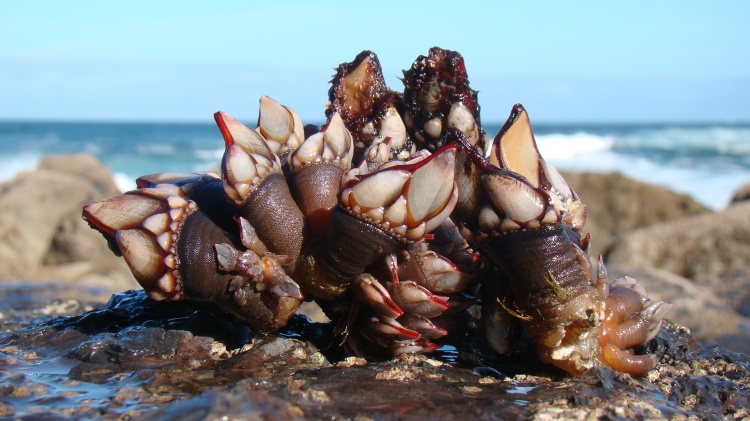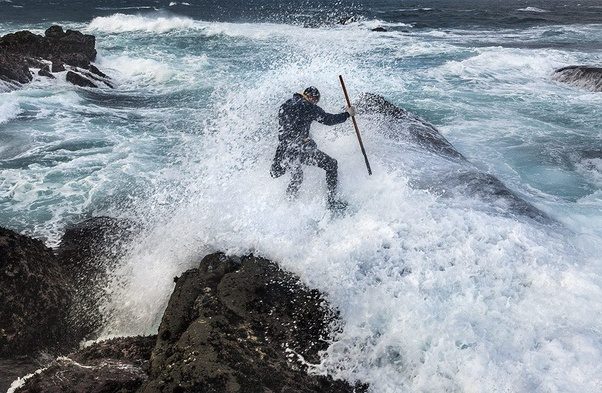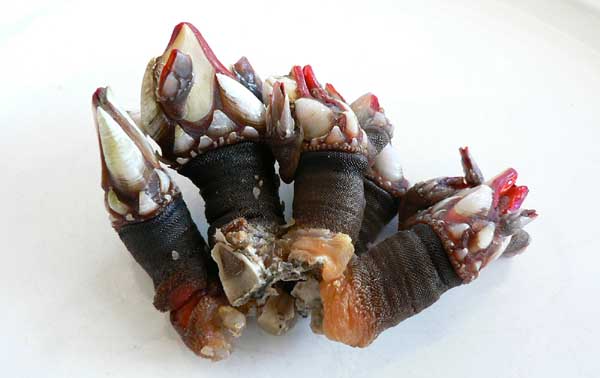This Christmas and New Year gooseneck barnacles were one of the prized dishes on the dinner table. Known as Percebes in Spanish, they are so called because of their resemblance to a goose’s neck and head but could easily be mistaken for alien beings. This barnacle forms dense colonies in crevices on rocky shores with strong waves. Barnacles anchor themselves to rocks by a tough, flexible stalk (peduncle), which also contains the ovaries. This is actually their “head” end.

Once the gooseneck barnacle has attached itself to an object, it secretes a series of pale plates at the end of its stalk, forming a shell around its featherlike legs, which comb through the water for food. The legs face away from the sea, enabling the barnacle to feed by filtering out particles of detritus from returning tidal water as it funnels past them through cracks in the rocks. Gooseneck barnacles become sexually mature at about five years of age and may live for up to 20 years. The larval stage is free-living but depends on sea currents for its transport and survival. Colonies of gooseneck barnacles are susceptible to the damaging effects of oil pollution and they recover only slowly from disturbance.
On northern Spain’s "Coast of Death" local men (percebeiros) risk their lives searching the jagged cliffs for gooseneck barnacles, a rare delicacy for which consumers will shell out hundreds of euros. It is here, where the roaring surf crashes wildly on to the rocks where the largest and fattest examples – the ones that bring in the most money – grow.
Galicia is a relatively poor region of Spain: there are few jobs and none that pay well. The shipbuilding industry, once the pride of Galicia, is in ruins, and the sea is overfished. Hunting for gooseneck barnacles is one of the few ways in which to earn money. Gourmets pay a high price for the rare stalked crustaceans: in a restaurant a plateful can cost €100. On the eve of important festivities, fishermen can make up to €300 per kilo at auction – with luck they can earn €1,000 in a day. But the stakes they play for are high; this is a dangerous way to make a living.
The Costa de la Muerte, the Coast of Death, is the region between the fishing village of Malpica in the north and Cape Finisterre, so called because of tricky northwesterlies and barely concealed rocks, which have often proved fatal for fishermen and seafarers. One of the worst tragedies occurred in 1595, when 25 ships of the Spanish Armada were hit by a storm and 1,705 sailors died. In the past five centuries more than 500 ships have capsized and thousands of seamen drowned. Many of these were ‘percebeiros’. On average, five fishermen die every year.
Conditions must be perfect to harvest gooseneck barnacles: good weather, a quiet sea and the right point in the lunar cycle. Spring tides and a particularly low ebb happen every two weeks, with a full and a new moon; at all other times the long-necked barnacles are underwater. The lower the sea level, the better, as the barnacles usually live below the waterline, where they are safe from predators.
Barnacles are a genus of primitive invertebrates that have populated the oceans for 500 million years. Unlike other crustaceans, they cannot move. The larvae stick themselves firmly to rocks with their cement glands, and use the tentacles in their mouthparts to collect the plankton that is whipped up by the surf. In the mid-19th century Charles Darwin devoted eight years to studying a total of 10,000 specimens, which he arranged and classified in species and subspecies. This work helped him to develop his theory of evolution.
Firmly anchored on the rock face, gooseneck barnacles often live near mussels. But unlike these shellfish, they have resisted all attempts to breed them. Scientists suspect that they need the tides to survive, and it has proved impossible to recreate these conditions in a laboratory. They thrive in intertidal zones where there is particularly strong surf, so it is at these points that the best specimens, which fetch the highest prices at auction, can be found. Those that are easiest to reach, on the upper edge of the rocks, stay dry for too long during the ebb tide, and are as thin, mushy and tasteless as Moroccan gooseneck barnacles, which lack the mineral-rich Galician granite on which to flourish.


About 400,000kg of barnacles, valued at €10 million, are handled annually. Gooseneck barnacles taste so intensely of the sea that the secret of their preparation is extremely simple: you put them in boiling water, ideally sea water, for a couple of minutes, without any other seasoning. Purists say you should be able to taste the waves of the surf and the plankton on which the crustacean has fed. You break open the shell – using the thumbnail of one hand, at the point between the stalk and the end that looks like a hoof – and twist the barnacle apart, then suck the flesh from the black shaft, a ¾in-1½in, orange-brown rod that tastes like a combination of crab, shrimp and oyster. You can also eat the barnacles raw.
This video will give you an idea of what they go through to get these prized barnacles :